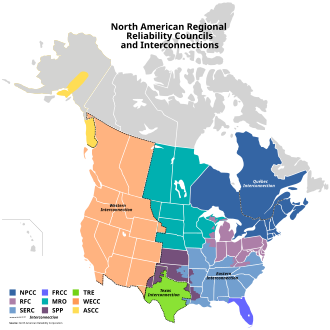
The Texas Interconnection is an alternating current (AC) power grid – a wide area synchronous grid – that covers most of the state of Texas. The grid is managed by the Electric Reliability Council of Texas (ERCOT).
The Texas Interconnection is one of the three minor grids in the North American power transmission grid. The other two minor interconnections are the Quebec Interconnection and the Alaska Interconnection. The two major interconnections are the Eastern Interconnection and the Western Interconnection. The Texas Interconnection is maintained as a separate grid for political, rather than technical reasons,[1] but can also draw some power from other grids using direct current DC ties. By not crossing state lines, the synchronous power grid is in most respects not subject to federal (Federal Energy Regulatory Commission) regulation.[2]
All of the electric utilities in the Texas Interconnection are electrically tied together during normal system conditions and operate at a synchronous frequency of 60 Hz.
- ^ Koerner, Brendan (August 18, 2003). "Why Texas has its own power grid". Slate. Retrieved February 21, 2021.
- ^ Galbraith, Kate (February 8, 2011). "Texplainer: Why Does Texas Have Its Own Power Grid?". The Texas Tribune. Retrieved February 16, 2021.
© MMXXIII Rich X Search. We shall prevail. All rights reserved. Rich X Search
